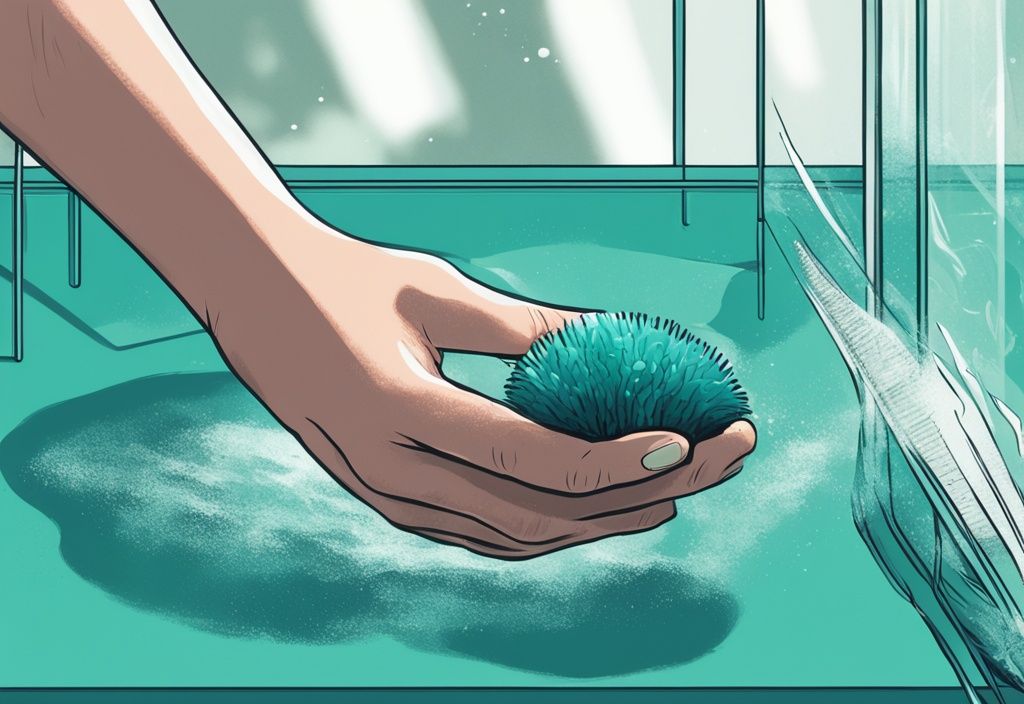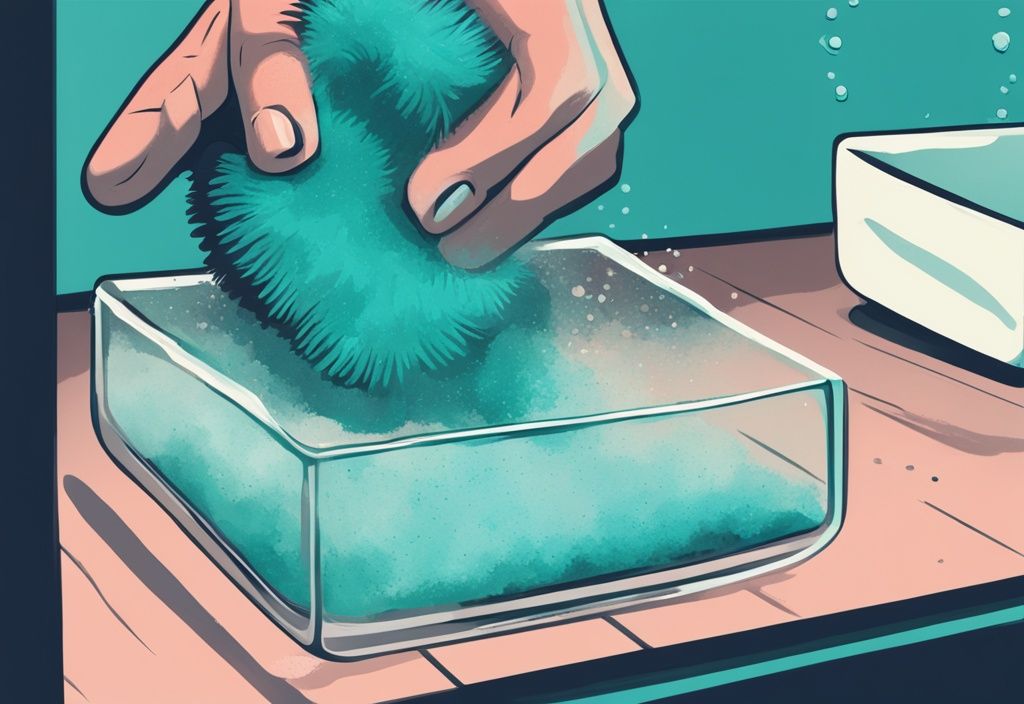Are you ready to bring the sparkle back to your aquarium glass? Dr. Melanie Rivers here to set you off on the right path to achieve crystal clear views. Recognize that a spotless aquarium glass not only elevates the aesthetic appeal of your fish tank but also plays a pivotal role in maintaining a wholesome environment for your aquatic friends.
You might be at a loss about how to clean aquarium glass properly, but don’t you worry! Let’s walk together through this comprehensive guide. We’ll delve into the whys and hows of glass cleaning, preparation steps, do-it-yourself cleaning methods neatly detailed, and sprinkle some expert pointers in between. All aimed at keeping your fish tank gleaming.
So, are you ready for an intriguing expedition to create a radiant, transparent aquarium that will be the delight of both you and your aquatic friends? Let’s dive in!
Why Cleaning Aquarium Glass is Essential
Regular maintenance of your aquarium glass is crucial for keeping the environment vibrant and healthy for your aquatic pets; for more comprehensive guidance on aquarium upkeep, consider visiting https://aquariumscience.org/index.php/18-aquarium-maintenance/. Knowing how to clean aquarium glass properly can make a significant difference in the aesthetics and health of your tank. Routine cleaning ensures that the view remains crystal clear, allowing for an unobstructed view of your colorful fish and well-maintained plants. This task is more than just about appearances; it has profound impacts on the well-being of your fish.
Algae and residue accumulation are common issues in aquariums. These unwelcome elements can obscure visibility, making it difficult to fully appreciate the beauty of your underwater world. Beyond the visual appeal, thick layers of algae can severely affect the health of your tank. Algae compete with plants for vital nutrients and light, which can stunt plant growth and alter fish behavior by reducing light penetration. What was once a thriving ecosystem can quickly become a struggling one.
Moreover, dirty glass can inhibit light from reaching the plants and fish within the aquarium. Light is essential for the photosynthesis process in plants, affecting their growth and oxygen production. Fish also rely on adequate light for natural behaviors and maintaining overall health. When light is obstructed, it can lead to stress and disorientation in fish, making them more vulnerable to diseases.
Cleaning aquarium glass is also crucial to prevent the buildup of harmful substances. Over time, organic waste, minerals, and chemicals can accumulate on the glass, creating an unhealthy environment for aquatic life. Removing these substances is essential in maintaining water quality, ensuring that your fish’s habitat closely mimics natural conditions. Regular cleaning minimizes the risk of health issues stemming from poor water conditions, such as fin rot, fungal infections, or other stress-related illnesses.
Incorporating regular glass cleaning into your tank maintenance routine is pivotal. It ensures your aquarium is not only a visually appealing centerpiece but also a healthy, thriving environment for your fish and plants. Understanding how to clean aquarium glass correctly can transform your care routine, ensuring you provide the best habitat for your aquatic friends.
Preparations Before Cleaning Aquarium Glass
Ensuring the proper steps are taken before cleaning aquarium glass can make all the difference in maintaining a healthy and balanced aquatic environment. Here, we’ll delve into essential preparatory steps, focusing on relocating fish safely and understanding the draining process.
Relocating Fish and Taking Safety Measures
Cleaning your aquarium glass might seem straightforward, but it’s crucial to manage it carefully to avoid stressing or harming your fish. Begin by gently moving your fish to a holding tank. This temporary home should replicate the water conditions of the main tank, including temperature and pH levels. This consistency helps to minimize stress—a calm fish is a healthy fish.
To create this safe environment, use a dedicated container for the holding tank. Mimicking water parameters closely is key to a smooth transition. Additionally, wearing gloves while working with aquarium water is a good practice. Not only does it shield you from potential contaminants, but it also prevents the transfer of oils and residues from your skin to the tank water, ensuring the health of your aquatic friends.
Draining the Aquarium
The extent to which you drain the aquarium largely depends on the intensity of cleaning required. If you’re dealing with a minor algae issue, a partial drain will likely suffice. However, for more thorough cleaning, a complete drainage might be necessary.
Start by removing any plants, decorations, or other elements. These should be placed in a bucket filled with tank water to preserve beneficial bacteria. This step ensures you can access all the glass surfaces effectively. Always position the tank on a towel after draining it completely. This provides a soft surface, preventing scratches on the glass and offering additional stability.
By meticulously preparing and following these steps, you’ll be able to maintain a pristine and healthy environment for your aquarium inhabitants.
Step-by-Step: How to Clean the Inside of the Aquarium Glass
When it comes to maintaining a clear and healthy aquarium, knowing how to clean the aquarium glass properly is crucial. This section covers the essential tools and techniques you need.
Using a Sponge, Scraper, or Aquarium Magnet
Learning how to clean aquarium glass involves selecting the right tools to preserve both clarity and the integrity of the glass. A dedicated cleaning tool, such as a sponge or window scraper designed specifically for aquarium use, is essential. Make sure this tool hasn’t been previously used for any household cleaning to avoid introducing harmful chemicals or residues into the tank.
One of the most convenient and effective tools is the aquarium magnet. It allows you to clean the inside of the glass from the outside. The magnet’s rough-textured side goes inside the tank, scrubbing away residues, while the exterior side glides along the outside. This method reduces the need to immerse your hands in the water, minimizing stress for the fish and maintaining water quality.
Avoid using metal scrapers as they can easily scratch the glass, which can compromise its clarity and strength. For stubborn algae stains that resist standard scrubbing tools, consider using a razor blade or a plastic algae scraper. When using these tools, always scrape in the direction of the glass grain to prevent any accidental damage.
Regular maintenance is key to preventing heavy algae buildup. Consistent cleaning makes subsequent sessions easier and less time-consuming. By following these detailed steps and using the appropriate tools, you ensure your aquarium glass remains pristine, enhancing your viewing experience and promoting a healthy environment for your aquatic life.
Step-by-Step: How to Clean the Outside of the Aquarium Glass
Maintaining the pristine condition of your aquarium glass enhances not only your view but also the well-being of your aquatic friends. The following approach ensures a spotless, clear exterior without compromising on safety or effectiveness.
Using Non-abrasive Cloths and Safe Cleaning Sprays
Cleaning the outside of your aquarium glass effectively requires using the right tools and techniques to ensure you do not inadvertently cause scratches or leave streaks. Here’s how to clean aquarium glass from the outside:
Start by selecting non-abrasive microfiber rags or chamois cloths. These materials are specifically designed to polish and clean glass surfaces without causing scratches or leaving lint behind. Unlike paper towels, which can gradually build up microscopic scratches that damage the clarity of your glass, microfiber and chamois cloths are gentle yet effective.

When it comes to cleaning sprays, opt only for aquarium-safe glass cleaners or fish-safe cleaning sprays that you can find at pet stores. Household cleaners may contain residues or chemicals that are harmful to your fish if they somehow make their way into the water. Always read product labels to ensure safety for aquatic life. Spray a small amount on your chosen cloth—not directly on the glass—to avoid any potential contamination.
Proceed by gently wiping the exterior surface in a circular motion, ensuring even distribution of the cleaning product. This helps in removing smudges, fingerprints, and other residues without a risk of streaks. Pay special attention to areas near the waterline, as these spots may accumulate more grime over time.
Regularly maintaining the outside of your aquarium glass using these optimal materials and safe products will enhance your tank’s aesthetic appeal and provide a clearer, unobstructed view of your vibrant, underwater world. The goal is not just a clean look but also ensuring a safe environment for the aquatic inhabitants inside.
Benefits and Method of Using Vinegar
Vinegar is a safe, natural solution for those looking to learn how to clean aquarium glass effectively, particularly when dealing with stubborn limescale deposits.
Its non-toxic properties make it an ideal choice for maintaining a healthy environment for your aquarium’s inhabitants.
First, apply the vinegar directly to a soft cloth or spray it onto the aquarium glass. This ensures thorough application to the areas affected by limescale. If you’re interested in upgrading your setup, check out our guide on the 7 best 5 gallon fish tanks for compact and efficient options. Allow the vinegar to sit on the glass surface for approximately 10 to 20 minutes. This waiting period is crucial as it provides adequate time for the vinegar to break down the limescale effectively.
After allowing the vinegar to sit, use a non-abrasive pad or cloth to scrub the glass gently. This step is important to avoid scratching the glass surface while ensuring the limescale is removed. It’s essential to choose the right type of cloth or pad to prevent any accidental damage to the glass. If you’re setting up a small aquarium, you might wonder what fish for 3 gallon tank might suit your needs. Once the scrubbing is complete, it is vital to rinse the glass thoroughly. Ensure all vinegar residues are removed by rinsing the glass several times with clean water. Residual vinegar can be harmful to the fish, so a comprehensive rinsing process is paramount.
Incorporating vinegar into your aquarium maintenance routine offers a chemical-free method to enhance the clarity and cleanliness of the glass. Its natural properties make it an excellent choice for those who prioritize the health and well-being of their aquarium inhabitants while maintaining an immaculate display. Understanding how to clean aquarium glass with vinegar ensures a pristine and safe aquarium environment for your fish.
Safely Removing Limescale and Salt Residues from Aquarium Glass
Key Prevention Tips for Avoiding Limescale and Salt Creep
Limescale and salt residues not only obscure the visibility of your beautiful aquatic environment but also detract from the aesthetic appeal of your aquarium. Preventing the buildup of these substances is crucial for maintaining a pristine tank. Here are some essential steps to minimize limescale and salt creep:
- Monitor the Water Line Regularly: One of the primary culprits behind limescale and salt creep is water evaporation. Evaporation can be subtle but by keeping a close eye on the water line, you can identify and address evaporation before it leads to significant residue buildup.
- Use Distilled Water to Replace Evaporated Water: Instead of regular tap water, consider using distilled water to replenish evaporated water. This practice helps avoid increasing the mineral concentration, a primary factor in limescale formation. Think of distilled water as a blank slate for your tank.
- Maintain Mineral Levels through Partial Water Changes: During regular partial water changes, use regular hard water. This method helps retain necessary minerals and maintains the pH balance, essential for a stable and healthy tank environment. Your aquatic friends need these minerals just as much as you need your morning coffee!
- Conduct Regular Water Tests: Keep a water test kit handy to continually monitor and measure essential water parameters such as pH, General Hardness (GH), and Carbonate Hardness (KH). Ensuring these parameters remain within safe ranges will help keep your aquarium environment conducive for your fish while reducing the risks of limescale and salt residue development.
By integrating these practices into your aquarium maintenance routine, you can significantly reduce the risk of unsightly limescale and salt creep. This proactive approach on how to clean aquarium glass ensures your tank stays visually clear and healthy, reflecting your dedication and care.
Tips and Tools to Keep Your Aquarium Glass Clean Longer
Understanding how to clean aquarium glass effectively is crucial for maintaining a visually appealing and healthy aquatic environment. Let’s explore some key practices and tools that can help you sustain crystal-clear aquarium glass.
Feeding Practices, Lighting Conditions, and Water Conditioners
Feeding Practices

Feeding your fish the right amount is essential in maintaining clean aquarium glass. When uneaten fish food lingers, it pollutes the water and fosters an environment conducive to algae growth. Feed your fish just enough to be consumed within a few minutes. Consistently remove any leftover food to prevent it from decaying and encouraging algae proliferation.
Lighting Conditions
Regulating lighting conditions within your aquarium is another critical factor. Excessive light can drive unchecked algae growth, swiftly clouding your glass and giving your tank a murky appearance. Aim to limit lighting to around 10 hours a day. Planting live plants in your aquarium can naturally control algae by competing for nutrients, thereby reducing algae growth.
Water Conditioners
Using water conditioners specifically designed for aquariums can significantly cut down on residue buildup on the glass. These conditioners maintain optimal water quality by balancing minerals and preventing harmful deposits that can cloud your tank. Regularly using conditioners means less frequent and intensive cleaning of your aquarium glass.
Regular Exterior Cleaning
Never underestimate the importance of maintaining the exterior glass of your aquarium. Dust, fingerprints, and smudges can undermine the clarity you’ve worked so hard to achieve. Use non-abrasive microfiber or chamois cloths to gently clean and polish the exterior glass. Ensure any cleaning sprays or solutions you use are aquarium-safe to avoid potentially harmful residues affecting the interior water quality.
By consistently implementing these practices, you’ll keep your aquarium glass cleaner for longer, enhancing both the visual appeal and the health of your aquatic environment.
Essential Weekly and Monthly Aquarium Cleaning Tasks
Importance of Monitoring Water Quality Regularly
Regularly monitoring water quality is critical to maintaining a clean and healthy aquarium. Consistent upkeep prevents the buildup of hard algae, which not only looks unsightly but can also be challenging to remove and increase the risk of scratching the aquarium glass. Keeping a vigilant eye on water quality helps identify when it’s time to clean the aquarium glass. Signs such as algae accumulation, unclear water, and visible grime suggest that cleaning is overdue.
Using a water test kit to measure pH, hardness (GH), and alkalinity (KH) ensures the aquatic environment remains safe for fish. Maintaining proper water parameters helps minimize algae growth and other issues that can affect the cleanliness of the glass.
Routine Cleaning Schedule
Establishing a routine cleaning schedule is crucial for maintaining a pristine tank. Here’s a suggested plan to keep your aquarium in top shape:
- Weekly Tasks: Perform partial water changes (10-20% of the tank volume) to remove debris and maintain water quality. Clean the inside of the aquarium glass using a dedicated sponge or scraper to remove any new algae growth. Check and clean the filter media to ensure efficient filtration.
- Monthly Tasks: Deep clean the substrate by vacuuming to remove accumulated waste and uneaten food. Inspect and clean decorations and plants to prevent the buildup of algae and other residues. Test the water parameters using a test kit to ensure stability and make adjustments if necessary.
By following a structured cleaning routine, you’re on the right path to learning how to clean aquarium glass effectively. This systematic approach not only enhances the visual appeal of your aquarium but also promotes a healthier environment for your fish, ensuring a thriving aquatic habitat.
Major Mistakes to Avoid While Cleaning Aquarium Glass
When considering how to clean aquarium glass, it is essential to use the proper techniques and tools to prevent damage and maintain a healthy environment for your aquatic pets. Here are some common mistakes to avoid:
Avoid Using Metal Scrapers or Harsh Household Cleaners
Metal scrapers might seem efficient, but they can easily scratch the delicate surface of aquarium glass, creating permanent damage. Opt for plastic or wooden algae scrapers instead; they are gentle and effective. Harsh household cleaners, like bleach or ammonia-based products, can leave toxic residues harmful to your fish. Always use cleaning solutions labeled as aquarium-safe to ensure your aquatic ecosystem remains safe and vibrant.
Be Cautious with Magnetic Glass Cleaners
Magnetic glass cleaners offer convenience but can cause scratches if misused. These cleaners can trap particles like sand or gravel between the magnet and the glass, resulting in unintended scratches. Always inspect the magnetic cleaner for debris before use and ensure the center magnet doesn’t come into direct contact with the glass surface.
Avoid Using Paper Products Like Paper Towels
Though paper products might seem harmless, they can cause minute scratches on the glass over time, which can accumulate and become noticeable. Instead, use non-abrasive microfiber cloths or chamois cloths that clean effectively without causing damage. These materials provide a gentle yet efficient cleaning method, ensuring your aquarium glass stays pristine.
Do Not Leave the Aquarium Magnet Inside the Tank
Leaving the aquarium magnet inside the tank when not in use can lead to unintended consequences. Over time, magnets can attract metallic particles, which can scratch the glass if not cleaned regularly. Additionally, prolonged exposure to water can degrade the magnet, reducing its effectiveness. Always store the magnet in a dry place to maintain its integrity and protect your aquarium glass.

Implementing these precautions will help you master how to clean aquarium glass without causing damage or harm to your aquatic pets. With the right tools and techniques, maintaining a clear and beautiful aquarium becomes a straightforward task that ensures a healthy and vibrant environment for your aquatic friends.
FAQs on Cleaning Aquarium Glass
What are the Best Tools for Cleaning Aquarium Glass?
Maintaining a pristine aquarium requires the right tools. Here’s a breakdown of your most effective options:
- Dedicated Sponge or Window Scraper: Ideal for removing algae without causing scratches, ensuring your glass remains clear.
- Plastic or Wooden Algae Scrapers: These offer gentle yet effective methods for handling those tough, stubborn stains without the risk of scratching.
- Aquarium Magnet: Featuring a rough side for inside cleaning and a handling side for the exterior, it brings both efficiency and convenience to your cleaning routine.
- Non-abrasive Pads or Cloths: Excellent for scrubbing the glass without introducing any scratches, keeping it in perfect condition.
- Razor Blade: For extremely stubborn algae, using a razor blade carefully in the direction of the glass grain can be effective. Just proceed with caution to avoid damage.
- Microfiber Rags or Chamois Cloths: These are perfect for polishing the exterior glass to achieve a streak-free, gleaming finish.
How Often Should I Clean My Aquarium Glass?
The frequency of cleaning your aquarium glass largely depends on algae growth. Typically, cleaning the inside of the glass weekly or biweekly should suffice. As for the exterior, wipe it as needed to maintain clarity and a polished look. Regular maintenance is key to preserving the beauty of your aquatic environment.
Is It Safe to Use Vinegar for Cleaning Aquarium Glass?
White vinegar serves as a safe and natural cleaning agent for tackling limescale and other residues on aquarium glass. Its acidic nature breaks down mineral deposits effectively. However, it’s crucial to rinse thoroughly after using vinegar. This ensures no residues are left behind, which could potentially harm your aquatic inhabitants.
Can Algae Eaters Help Keep the Glass Clean?
Yes, certain algae eaters can be quite beneficial. Species like Amano shrimp, catfish, and Ramshorn snails actively consume algae, aiding in the cleaning process. However, their compatibility with your tank depends on factors such as tank size, whether it’s a freshwater or saltwater setup, and the existing inhabitants. Introducing these natural cleaners can create a balanced ecosystem while reducing your manual cleaning efforts.
How to Avoid Scratching Aquarium Glass During Cleaning?
Protecting your aquarium glass from scratches during cleaning is essential. Here are some expert tips:
- Plastic or Wooden Algae Scrapers: Prefer these over metal scrapers to minimize the risk of scratching the glass surface.
- Non-abrasive Pads or Cloths: Use these gentle scrubbing tools to clean without causing damage.
- Magnetic Cleaners: Be mindful to prevent these from picking up any abrasive particles that could scratch the glass.
- Scrape in the Direction of the Glass Grain: Always align your scraping motion with the glass grain to avoid any inadvertent damage.
Conclusion
Maintaining your aquarium glass through regular cleaning is not merely a cosmetic endeavor—it is crucial for fostering a healthy and visually appealing environment for your fish. Understanding how to clean aquarium glass ensures that your aquatic pets have the best possible habitat, free from harmful residues and obstructions to light.
Using the appropriate tools and techniques is vital when you embark on the task of cleaning your aquarium glass. Opt for dedicated sponges, plastic or wooden scrapers, and non-abrasive pads to avoid damaging the glass. Just like a surgeon needs the right scalpel, you need the right tools to keep your tank pristine. Additionally, remember that the use of an aquarium-safe magnet cleaner can be particularly effective, provided you exercise caution to prevent any scratching from trapped particles.
Regular maintenance, such as frequent monitoring and cleaning, plays a significant role in preventing persistent algae growth and residue buildup. Set a consistent cleaning schedule to tackle attributes like hard algae before they become ingrained, thereby making the cleaning process smoother and less abrasive on your tank glass. Think of it as a routine health check-up for your aquarium, ensuring everything stays in top-notch condition.
Incorporating preventative measures is an often overlooked yet essential aspect of keeping your aquarium glass clean. Appropriate feeding practices, regulated lighting conditions, and the use of water conditioners can drastically minimize the proliferation of algae and other residues. Feeding only the necessary amount, limiting illumination to around 10 hours a day, and adopting aquarium-safe water conditioners will aid in preserving the clarity and cleanliness of the glass. Imagine it as a balanced diet and exercise routine for your aquatic pets—the right balance makes all the difference.
By diligently adhering to these maintenance routines and leveraging the right tools and methods, you can effortlessly maintain an aquarium that is not only a visual delight but also a safe and thriving environment for your fish. Your underwater world can be a serene escape, a miniature ecosystem where both you and your aquatic friends can enjoy a harmonious and sustainable relationship.
